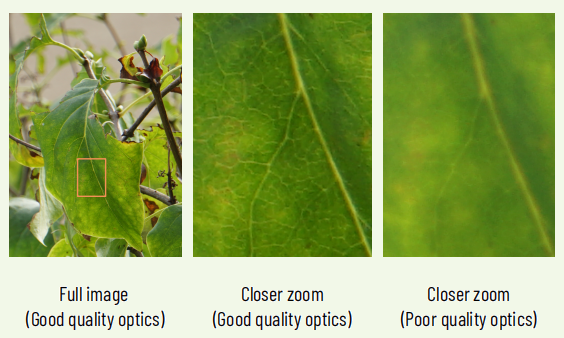In today’s image-driven world, the importance of high-quality lenses and optics cannot be overstated. Whether it’s capturing microscopic images, observing distant galaxies, or performing precision measurements in a lab, the quality of the lens and its optical components plays a pivotal role in ensuring clarity, detail, and accuracy.
The Basics of Optics and Lenses
At its core, optics is the branch of physics that deals with the behavior and properties of light, particularly its interactions with different materials. In scientific imaging, optics refers to the way light travels through various lenses and optical systems to create detailed and accurate images.
Key Concepts in Optics
Refraction: Refraction occurs when light passes through one medium to another, causing it to bend. The degree of bending depends on the angle at which light enters the medium and the refractive index of the material.
Diffraction: This is the bending of light around obstacles and the spreading of light waves as they pass through small openings. Diffraction limits the resolution of lenses, especially in optical systems that require high precision, such as microscopes.
Focal Points: The focal point of a lens is where parallel light rays converge after passing through the lens. The distance from the lens to the focal point is called the focal length, a crucial factor in determining the lens’s magnification power.
Basic Types of Lenses
Convex Lenses: These lenses are thicker at the center than at the edges. They are used to focus light and are commonly found in microscopes, telescopes, and cameras.
Concave Lenses: Thinner at the center and thicker at the edges, concave lenses diverge light. These are typically used to correct vision issues like nearsightedness but can also be part of optical systems to manipulate light in certain ways.
Understanding these basic optical principles is essential for selecting and working with lenses in scientific cameras.
Types of Lenses Used in Scientific Cameras
Scientific cameras are designed for specialized purposes, whether for analyzing minute biological samples or capturing distant celestial bodies. The types of lenses used in these cameras vary depending on the application.
Objective Lenses
Objective lenses are the most crucial lenses in a scientific camera, especially in microscopy. These lenses directly influence magnification and resolution. Objective lenses in microscopes, for example, come in different magnification levels, often ranging from 4x to 100x. The higher the magnification, the smaller the details the lens can resolve.
Wide-Angle vs. Telephoto Lenses
-
Wide-Angle Lenses: These lenses have a short focal length and can capture a larger field of view. They are useful in scientific imaging when you need to capture a broad area, such as in environmental science or astrophotography.
-
Telephoto Lenses: These lenses have a longer focal length, allowing them to magnify distant objects. They are particularly valuable in astronomy and certain types of industrial imaging, where details from far away need to be captured.
Macro Lenses
Macro lenses are specially designed for extreme close-up photography, enabling high magnification and sharp detail. In scientific fields like biology or materials science, macro lenses are essential for capturing intricate textures and fine details of small samples.
Specialized Lenses
In some scientific applications, such as infrared or ultraviolet imaging, specialized lenses are used to capture light outside the visible spectrum. These lenses are tailored to transmit specific wavelengths of light, which is vital for fields like astronomy, environmental science, and medical imaging.
Use of Lenses to Magnify and Demagnify
In microscopes, the objective performs the principal magnification, but there are often options for additional magnification or demagnification between the objective and the camera. These can be used to change camera pixel size to improve sensitivity (demagnifying, additional magnification < 1), or reduce pixel size to achieve optimal Nyquist sampling (additional magnification > 1).
They are also used to increase the FOV, or fit the microscope’s output to a smaller sensor camera – both through demagnification. The total magnification of the system is the product of the magnifications of each magnifying component.
Drawbacks of using extra magnification
It is worth treating additional magnification with caution, as each additional air/glass interface added to an optical system, of which each lens, of course, has two, scatters or reflects up to 4% of the light that passes through it, meaning that only around 90%-95% of the light reaches the next optical element.
Further, microscope objectives are extensively designed and engineered to provide a high-quality aberration-free image, even out to the edges of the field of view. Additional magnification optics, on the other hand, may be significantly lower in quality. The effect of this will be most noticeable at the edges of the field of view – the exact areas that the lens was introduced to show, in the case of using additional optics to increase field of view. Where possible, the magnification should be set by the objective, and additional magnification lenses should be carefully considered.
Key Optical Features and Specifications
In scientific imaging, the ultimate resolution of a lens is limited by the physics of light diffraction, but in practice, lens quality and design determine how close we can approach this theoretical limit. When choosing lenses for scientific cameras, several key optical features and specifications must be considered to ensure the best image quality and performance.
Lens-based Optical Resolution

Figure 1: Optical quality matters for resolution
This leaf was imaged with the same camera using two lenses of identical focal length, but very different build quality. The zoom image on the right shows the loss in resolution capability for the poor quality lens, compared to the good quality lens (center).
In the case of lens-based imaging, reaching diffraction-limited resolution is rare at larger lens apertures, as other optical effects may introduce distortions and blurs. The best-case scenario is once again the diffraction-limited case, as defined previously for microscope resolution. However, for lenses with adjustable focal plane, it is more meaningful to define resolution in terms of angle relative to the optical axis than distance at the focal plane. The diffraction-limited resolution of a lens is therefore given by:
θ = 1.22 λ/D
Where θ is the angular resolution, λ is the wavelength of detected light, and D is the lens aperture diameter. This diameter can be easily calculated from the lens ‘aperture stop’, e.g., f/2.4 or f/8. The ‘f’ refers to the focal length, which if substituted in, provides the aperture diameter D.
The resolution of a real lens however is best represented by the MTF as described on the previous page. Advice on MTF measurement can easily be found online, such as "Introduction to Modulation Transfer Function".
Optical Aberrations
Even with diffraction limited design, real lenses suffer from optical aberrations—imperfections that distort images:
● Spherical Aberration: Rays at different distances from the lens axis focus at different points, reducing sharpness.
● Chromatic Aberration: Different wavelengths of light focus at different distances, causing color fringing.
● Astigmatism: Points off the optical axis appear stretched in one direction.
● Field Curvature & Distortion: The image plane is not perfectly flat, leading to warped or blurred edges.
High-quality scientific lenses use advanced designs (aspherical elements, achromatic doublets, multi-element groups) to minimize these aberrations. For applications like microscopy and semiconductor inspection, correcting aberrations is as important as maximizing resolution.
Optical Coatings
Optical coatings are thin layers applied to lens surfaces to improve performance.
● Anti-Reflective (AR) Coatings: Reduce surface reflection from about 4% per interface (96% transmission) down to less than 0.5% (over 99% transmission) with advanced multi-layer coatings.
● Multi-Layer Coatings: Optimize transmission across broad wavelength ranges, essential for life science cameras covering UV to near-IR.
● Specialized Coatings: Tailored for infrared or ultraviolet imaging in astronomy or medical imaging.
● Protective Coatings: Improve durability in harsh environments, useful in industrial and outdoor applications.
These coatings are crucial for reducing stray reflections, increasing contrast, and ensuring high-fidelity imaging.
Choosing the Right Lenses for Different Scientific Applications
The right lens depends on the scientific application.
Microscopy
In microscopy, lenses are chosen based on their ability to magnify and resolve fine details. The most common lenses are objective lenses, which vary in magnification. For high-resolution work, such as studying bacteria or viruses, oil immersion lenses are often used, as they allow for greater light transmission and higher resolution.
Microscope optical resolution calculation
Due to the high quality of lens elements inside most microscope objectives, optical resolution for a microscope is often approximated by the diffraction-limited resolution, depending only upon the wavelength of light used and the aperture of the imaging lens(es).
For microscopes that use a separate illumination and imaging lens or objective, as in the case of the condenser lens used in transmitted light imaging or many ‘light sheet’ imaging techniques, the aperture of both lenses must be included. This formula defines resolution according to the Rayleigh Criterion in these cases:

Where λ is the wavelength of detected light, NA(cond) is the numerical aperture of the illumination or condenser lens, NA(obj) is the numerical aperture of the objective.
For reflected light imaging or typical fluorescence imaging where only one objective is used for both illumination and imaging, the equation simplifies to this:

The importance of high numerical aperture in resolving fine details is clear from the equations. The numerical aperture cannot be higher than the refractive index of whatever media fills the space between the imaging subject and the objective for conventional objectives. The refractive index of air is approximately 1.0, meaning NA cannot go higher than this for air objectives, hence the use of high-refractive-index immersion oils. Oil objectives can deliver numerical apertures up to around 1.6.
For applications where fine resolution is critical, and for scientists and engineers developing new microscopy setups and techniques, typically resolution is measured according to the Modulation Transfer Function discussed below, alongside the size and shape of the point spread function (PSF).
Medical Imaging
In medical imaging, lenses are critical in tools such as endoscopes, ophthalmic instruments, and fluorescence imaging systems. Unlike CT or X-ray machines, which rely primarily on detectors, these optical devices depend heavily on lens quality for clear and accurate diagnostics.
Industrial and Scientific Testing
Lenses used in industrial applications are often chosen for their durability and ability to operate in harsh conditions. For example, lenses used in non-destructive testing (NDT) or quality control in manufacturing must withstand extreme environments while delivering high-resolution images for precise measurements.
Astrophotography
Astrophotography requires lenses with long focal lengths to capture distant celestial objects. These lenses often feature a narrow field of view and high resolution. Telescopes are a common tool in this field, but specialized lenses are also used to capture details of stars, planets, and galaxies.
How to Maintain and Care for Your Lenses and Optics
Lenses and optical components are sensitive and require proper care to maintain their performance. Here are some essential maintenance tips:
● Cleaning: Always use a lens cleaning solution and a microfiber cloth to gently remove dust or smudges. Avoid using paper towels or rough cloths that can scratch the surface.
● Storage: Keep lenses in a clean, dry environment, preferably in a protective case or lens cap to prevent damage.
● Regular Calibration: Regular calibration is necessary to ensure that the lenses continue to deliver accurate results, particularly in scientific applications where precision is key.
Conclusion
Lenses and optics are integral to the performance of scientific cameras. Whether you’re working with microscopes, telescopes, or specialized industrial cameras, understanding how lenses function and how to choose the right one for your needs is essential for obtaining accurate and high-quality images. By keeping up with advancements in lens technology and maintaining your equipment properly, you can ensure that your scientific imaging systems continue to perform at their best.
Tucsen Photonics Co., Ltd. All rights reserved. When citing, please acknowledge the source: www.tucsen.com


 2025/10/09
2025/10/09







